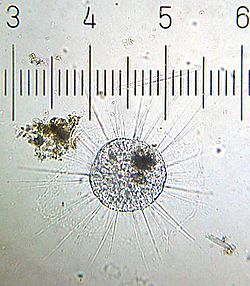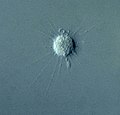Top Qs
Timeline
Chat
Perspective
Axodine
Class of single-celled organisms From Wikipedia, the free encyclopedia
Remove ads
The axodines are a group of unicellular stramenopiles that includes silicoflagellate and rhizochromulinid algae, actinomonad heterotrophic flagellates and actinophryid heliozoa. Alternative classifications treat the dictyochophytes as heterokont algae, or as Chrysophyceae.[4] Other overlapping taxonomic concepts include the Actinochrysophyceae, Actinochrysea or Dictyochophyceae sensu lato. The grouping was proposed on the basis of ultrastructural similarities, and is consistent with subsequent molecular comparisons.[5]
The Axodine grouping was unusual in breaking with the traditions of botanical and protozoological taxonomy to include the actinophryid heliozoa as part of the lineage that also contained the pedinellid algae along with colorless relatives such as Actinomonas, Pteridomonas, and Ciliophrys; the axodines further included the silicoflagellates, and Rhizochromulinales.[3] This followed a growing consensus that the actinophryid heliozoa were not related to other types of heliozoa.[6][7][8]
Remove ads
Characteristics
The name points to a character that is deemed to be synapomorphic for the group: that is the microtubular arrays that extend from the surface of the nucleus. Many flagellated forms have a single emergent flagellum, that lacks the root structure found in related chrysophytes.
- Siliceous skeleton of the dictyochid flagellate, Dictyocha fibula
- Actinophrys sol, living heliozoon
- Actinomonas - heterotrophic flagellate with single flagellum and stiff arms
- Ciliophrys infusionum, living flagellate
Remove ads
Classification and history


The traditional botanical treatment of the group follows
Order Dictyochales
The most notable group is the silicoflagellates, marine plankton that form siliceous skeletons and are well known as fossils.
Order Pedinellales
Most other axodines form a group variously called the pedinellids.
Order Rhizochromulinales
In addition to the silicoflagellates and actinodines, the marine amoeboid Rhizochromulina marina is included here based on the structure of its zoospores. It is considered closer to the latter group than the former.
Remove ads
References
Wikiwand - on
Seamless Wikipedia browsing. On steroids.
Remove ads





